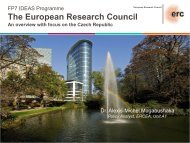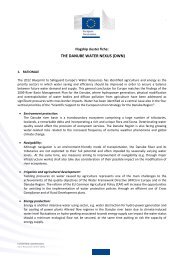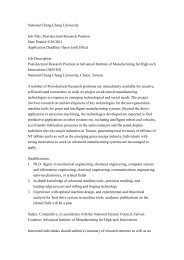Guide to Research and Innovation Strategies for Smart Specialisation
Guide to Research and Innovation Strategies for Smart Specialisation
Guide to Research and Innovation Strategies for Smart Specialisation
Create successful ePaper yourself
Turn your PDF publications into a flip-book with our unique Google optimized e-Paper software.
Universities<br />
Why should universities be part of smart specialisation?<br />
In the framework of the Education, <strong>Research</strong> <strong>and</strong> <strong>Innovation</strong> triangle, the so-called knowledge<br />
triangle, universities 71 have a crucial role <strong>to</strong> play in creating knowledge <strong>and</strong> translating it in<strong>to</strong><br />
innovative products <strong>and</strong> services, in cooperation with research centres <strong>and</strong> businesses.<br />
Successful mobilisation of the resources of the universities can have a strong positive effect<br />
on the achievement of comprehensive regional strategies.<br />
Universities dealing with economics, public policy <strong>and</strong> administration, as well as those<br />
dealing with specific policy areas (such as industry, health, agriculture, environment <strong>and</strong><br />
culture) can provide public authorities <strong>and</strong> private sec<strong>to</strong>rs with strategic advice, as well as<br />
experts <strong>to</strong> work directly on regional development priorities. Universities are a critical 'asset' of<br />
the region; even more in the less developed regions where private sec<strong>to</strong>r may be weak or<br />
relatively small, with low levels of research <strong>and</strong> development activity.<br />
There are a range of mechanisms by which universities can contribute <strong>to</strong> regional innovation<br />
systems. Universities can, <strong>for</strong> instance, stimulate the entrepreneurial spirit of its staff <strong>and</strong><br />
students, provide advice <strong>and</strong> services <strong>to</strong> SMEs <strong>and</strong> participate in schemes promoting the<br />
training <strong>and</strong> placement of high level graduates in innovative businesses. They can also host<br />
incuba<strong>to</strong>rs <strong>for</strong> spin-offs in science <strong>and</strong> technology parks <strong>and</strong> provide valuable input <strong>to</strong><br />
innovative clusters <strong>and</strong> networks. These mechanisms can be delivered as st<strong>and</strong> alone projects<br />
or within wider strategies. The latter is the ideal <strong>and</strong> will ensure maximum impact but is<br />
difficult <strong>to</strong> achieve as there are many barriers <strong>to</strong> overcome <strong>and</strong> there are few good practice<br />
examples <strong>to</strong> draw on. Also, Universities <strong>and</strong> Business should directly cooperate in curricula<br />
design <strong>and</strong> curricula deliver <strong>to</strong> ensure that graduates have the right skills <strong>and</strong> transversal<br />
competences. By having businesses cooperating with the education part of Universities talent<br />
attraction <strong>and</strong> retention in the region would be enhanced. Universities can also play an<br />
important role in the field of vocational training.<br />
Barriers <strong>and</strong> Challenges<br />
Improving the contribution of universities <strong>to</strong> regional growth by implementing such<br />
mechanisms requires interconnecting the partners of the innovation systems. 'Disconnections'<br />
can occur between the partners <strong>and</strong> the barriers <strong>to</strong> overcome are of different nature. They can<br />
be internal <strong>to</strong> the university <strong>and</strong> its capacity <strong>to</strong> ‘reach out’ <strong>to</strong> the wider region (i.e. supply<br />
side). For instance, universities are usually focused on teaching <strong>and</strong> research, driven by<br />
academic outputs, <strong>and</strong> are part of national academic systems that are not targeted <strong>to</strong> respond<br />
<strong>to</strong> regional needs. As a result, some universities are viewed as being 'in' the region but not 'of'<br />
the region where they are located.<br />
These barriers can also be linked <strong>to</strong> the capacity <strong>and</strong> willingness of the public <strong>and</strong> private<br />
sec<strong>to</strong>r ac<strong>to</strong>rs in the region <strong>to</strong> ‘reach in’ <strong>to</strong> the university <strong>to</strong> seek expertise <strong>and</strong> knowledge that<br />
can contribute <strong>to</strong> regional growth <strong>and</strong> development (i.e. dem<strong>and</strong> side). Successful partnerships<br />
involve 'boundary spanners' providing leadership within <strong>and</strong> across the partners <strong>and</strong> enabling<br />
71 The term 'university' includes all higher education institutions, in line with the Commission's Communication<br />
on the modernisation agenda <strong>for</strong> universities [COM (2006) 208].<br />
78

















